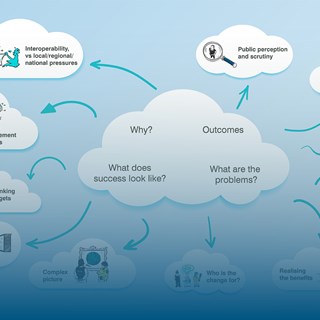
The role of artificial intelligence in digital transformation
This piece is the fourth article of our July issue of FOCUS, the theme of which is digital transformation.
12 August 2020
Dr Turkbeyler’s genuine interest in maths and physics guided her towards a degree in electrical engineering. Still, her journey into Artificial Intelligence began after she won a NATO Science Scholarship and started her PhD at Imperial College, London.
“This was towards the end of the 90’s”, she says, “when several scientific theories and techniques converged into AI.”
“Well,” says Dr Turkbeyler, “many of our customers ask the same thing, and really, they just want to understand how it can benefit their businesses. Artificial Intelligence algorithms”, she says, “are learning algorithms.”
“They aren’t rules-based; some even self-correct, learning from successes and failures. In short, they use computer systems to simulate how human intelligence works.
“AI can help make complex decisions at incredible speeds based on vast quantities of data, rather than human interpretation or instinct, which can be slow or flawed. They detect patterns, anomalies and threats and can produce predictive analyses to forecast what’s most likely to happen next and, therefore, what the best available option is expected to be, which is why they are so good for predictive maintenance and cyber security, as well as scheduling and planning.
“Given the data organisations now have access to, you can see why they want to understand it to make accurate analysis and predictions. And given its potential to save time and money, it’s clear why data has become so valuable.
"It also explains why human-machine teaming has thrived, because at what point do we let a computer make the decisions and what happens if an algorithm gets it wrong?"
After earning her PhD, Dr Turkbeyler started applying AI theories to solve real-world problems. She worked in computer vision, processing video footage by recognising images and detecting and tracking the movement of people.
“The development of computer vision learning algorithms was a great field to be working in at the time”, she says, “Humans take for granted the speed at which our brains can process the complexity of what our eyes are seeing, but computers struggled to make sense of these images, detect movement, and identify a person between the different field of views.”
 “The quality of video footage from static surveillance cameras can vary, as can the lighting, so we’d need to identify each problematic scenario and programme an algorithm to help a computer understand how to deal with it.
“The quality of video footage from static surveillance cameras can vary, as can the lighting, so we’d need to identify each problematic scenario and programme an algorithm to help a computer understand how to deal with it.
"With footage from a moving drone, for example, a computer would perceive everything to be moving, including the ground and buildings, so we’d have to programme algorithms that could differentiate between a building that’s actually static and the movement of people."
Towards the end of the 2000s, Dr Turkbeyler became Technology and Team Lead in Data and Information Fusion, where she and her team integrated data from multiple sources and sensor outputs such as sound, images and radar to enable computers to create a complete operational picture.
Their work with Bayesian networks taught algorithms not just to distinguish images but to start making decisions for themselves, the same technology used in autonomous ships and vehicles.
Later, Dr Turkbeyler and the team began working successfully with deep learning and deep neural networks because there was now an enormous amount of data available from social media in the form of text and images. At the same time, considerable advances in hardware processing power meant that they could train powerful new algorithms more quickly.
Now, it wasn’t just a case of recognising faces in images or identifying objects - industries could use AI to detect impurities in images and reveal imperfections in production line components that are invisible to the human eye, reducing future re-work.
Today, Dr Turkbeyler oversees a team of Data Scientists and AI specialists who apply AI in many fields, from satellite data, imagery, text data and natural language processing to cybersecurity.
"AI, together with Intelligent chatbots and robotics, are making a big difference to companies and are a relatable example of how cutting-edge technology like Artificial Intelligence and Deep Learning drives Digital Transformation and changes the way companies operate.
“There’s lots of hype about AI”, Dr Turkbeyler cautions. “But practical cases can vary widely, from helping companies gather and analyse data from sensors, images, files, audio, video and documents and collating these into a complete operational picture to using machine learning to digitise technical drawings and records, which is one of the first steps on the journey toward producing digital design twins.
“It can be about helping businesses with small Digital Transformation projects, where they can explore how AI can remove the manual aspects of what people do so that they can add value in other, more meaningful ways. In this context, human-machine teaming helps to build skills and confidence and drive the challenging cultural changes associated with Digital Transformation.”
CCTV cameras to detect ‘destructive and unusual behaviours’ can help prevent incidents by alerting an operative that someone might be about to engage in risky behaviour. Other commercial applications of AI include determining a person’s age or their sentiment from an image. In the rail industry. But, while these applications may set out to save lives, they do start to raise some very ethical questions.
"At BMT, we’re particularly mindful of how biases can pervade each stage of the data journey, from the origination of the data itself, to those tasked with using it to programme an algorithm. The team pays attention to the training data given to the algorithm to learn, to ensure inputs are varied and unbiased. If left unchecked, these biases can reinforce, rather than correct, the systems and practices that discriminate against vulnerable communities on the basis of race, ethnicity or disability, among other factors."
One such example is the idea that future crime can be predicted based on police data on arrests and incarcerations. It has been well-documented that these have disproportionately targeted the black community.
In this age of Digital Transformation, it’s more vital than ever that our scientists and engineers are as neurologically, ethnically and linguistically aware and diverse as possible.
“On a more positive note, we see the local government using AI to improve services by detecting graffiti and potholes, while utility companies can optimise energy usage by predicting demand and regulating the amount of renewable energy supplied to the grid.
“We’ve been able to use Deep Convolutional Neural Networks and Generative Adversarial Networks in Rapid AI Mapping project work, which turns satellite imagery into usable maps that allow geospatial analysts to automatically extract map features, like roads and buildings to support urgent disaster relief operations.”
“By mimicking nature and applying deep reinforced learning algorithms, our scientists have taught drones to perform a perched landing, as a bird would do and are now teaching a swarm of underwater vehicles to collect information collaboratively and return it for analysis”, Dr Turkbeyler shares. “This is something that would previously have been complex and expensive for human operators to do.”
BMT research and development also applies AI to traditionally computationally complex problems like fluid dynamics. Using our wind speed data sourced from thousands of liquid dynamics projects, we are working towards shortcutting the often expensive and time-consuming task of scale model testing, reducing the number of design iterations needed.
And this brings Dr Turkbeyler to the future of AI. “Robotics and AI will keep making our daily lives easier”, she suggests, “and we won’t even notice it’s happening. But trust and ethics will remain paramount, a principle she describes as ‘explainability’. In other words, we shouldn’t use AI algorithms if we can’t explain how they came to their decisions. At the same time, less scrupulous groups are using AI technology for political and financial gain whilst ignoring ethical standards. This issue must be understood and addressed, and testing and verification will dominate this field, especially for safety-critical systems.
"So, whilst this is an interesting time to be working in this field" says Dr Turkbeyler, "our focus remains on helping our customers to shape a future in which AI is ethical, accountable, responsible and transparent."

Esin has significant experience in AI for the last 30 years. She has developed several AI based solutions in Computer Vision. She has delivered many projects using earlier AI techniques to recent Deep Learning algorithms for Defence and private industry. She has been PhD supervisor to several students researching AI in the fields of Computer Vision and Knowledge Representation at leading UK Universities. Dr Turkbeyler now oversees a team of Data Scientists and AI specialists who apply AI in a huge range of fields, from satellite data, imagery, text data, natural language processing to cybersecurity.

N/A
In a world where complexity is the norm and certainty is rare, adaptability isn’t a luxury, it’s a necessity. And when we combine it with empathy, structure, and a commitment to quality, we create programmes that deliver real, lasting value.

Tim Curtis
Most transformation programmes fail—not because of poor execution, but because they never truly understood the race they were competing in. The BMT Strategy Canvas changes that.

Kathryn Walker
Coaching is a proven tool to support change leaders and their teams. The greatest impact and success has been achieved in transformation programmes, where structural and programmatic approaches are supported by attention to the cultural and behavioural aspects of change.

N/A
Delve into the top 10 challenges and interdependencies involved in selecting and adopting from the plethora of technological developments, and then embedding multiple new technologies in frontline UK policing, highlighting the multifaceted nature of this undertaking.